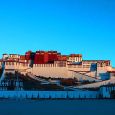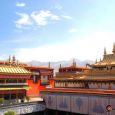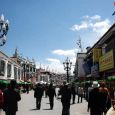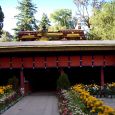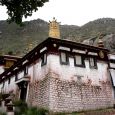Tibet
Advertisement
How to reach Tibet
To get to the Tibetan capital, Lhasa, foreign travelers usually start from Chengdu in Sichuan, Xining in Qinghai or Kathmandu in Nepal:
Air:
1) Chengdu, Sichuan to Lhasa Direct daily flights are available between Chengdu, Sichuan, and Lhasa. You can easily get a ticket through a travel agency in Chengdu. There is also a comfortable 2-hour flight twice weekly between Chongqing and Lhasa.
2) Kathmandu to Lhasa From April to November there are 2 flights a week available between the Nepalese capital and Lhasa. Schedule air services fly from Kathmandu to Lhasa, and back every Tuesday and Saturdays with additional flights on Thursdays from July. This flight last a little over one hour and gives you a panoramic view of the Himalayas. However, individual travelers can get neither a visa nor an air ticket, which are only available to members of an organized group.
Road:
1) Xining, Qinghai via Golmud to Lhasa, this bus trip is tough going and takes a minimum of 2 nights and 3 days along the Qinghai-Tibet Highway. Although uncomfortable this is still the most popular route for travelers sticking to land transportation.
2) Kathmandu via Dram (Khasa) to Lhasa As with the Qinghai-Tibet Highway, the China-Nepal Friendship Highway is a popular route for travelers. This route brings you close to a number of famous sights, such as Shigatse, Gyantse, and the Everest Base Camp. It takes 5-7 days of traveling over the Tibetan Highlands to get to Lhasa via this route. This overland trip also subjects individual travelers to the same restrictions as access by air from Nepal.
Holy Mount Kailash
Mt. Kailash (22028 Feet), considered to be a physical embodiment of the mythical Mt. Meru, is believed to be the most sacred mountain in the world. Its snow dusted rock pyramid is located in the scenically rich area of western Tibet, which lies between the Himalayas and Karakurum ranges. From its peak, one can enjoy the views of Afghanistan, Pakistan, India, and Nepal. It is considered most auspicious to make a religious pilgrimage around its fifty-three kilometres circuit (32 miles parikrama).
In fact, the entire region of Mt. Kailash is of important religious significance and includes the two turquoise-blue, pristine high-altitude lakes of Mansarovar and Rakshesa. Mt. Kailash is regarded holy by followers of several religions. To Hindus, Kailash is the abode of Shiva and nearby Manasarobar Lake, the soul of Brahma. Tibetans call Kailash Kang Rimpoche. Jains worship it as Mt Ashtapada, the peak from which the religion's founder, Rishabanatha, achieved spiritual liberation. And the followers of Bon-Po, the ancient pre-Buddhist shamanistic religion of Tibet, revere Kailash as the soul of Tibet.
Culture and Scenic Diversity
Tibet, one of the extra ordinary destinations where indeed adventure lurks around every corner. Its name the "Roof of the world" is not a mere statement. The valley bottoms of tibet are highter than the highest mountains elsewhere. Adventure on the road is never short on the beautiful Trans - Himalaya drive of over 970-kms, through four mountain passes, promising a panorama of a cultural and scenic diversity unsurpassable anywhere.
The Buddhist monasteries of Drepung, once the largest; the Jokhang- a spirtual centre, and the awesome palaces of the dalai lama. Norbulingka or the Summer Palace and the Potala - the Traditional Seat are some of the highlights of visit. For Tibetans, pilgrimage refers to the journey from ignorance to enlightenment, from self-centeredness and materialistic preoccupations to a deep sense of the relativity and interconnectedness of all life.
The Tibetan word for pilgrimage, neykhor, means "to circle around a sacred place," for the goal of pilgrimage is less to reach a particular destination than to transcend through inspired travel the attachments and habits of inattention that restrict awareness of a larger reality........By traveling to sacred sites, Tibetans are brought into living contact with the icons and energies of Tantric Buddhism. The neys, or sacred sites themselves, through their geological features and the narratives of transformation attached to them, continually remind pilgrims of the liberating power of the Tantric Buddhist tradition.......Over time pilgrimage guidebooks were written, giving instructions to pilgrims visiting the holy sites and accounts of their history and significance. These guidebooks, neighs, empowered Tibet and its people with a sacred geography, a narrated vision of the world ordered and transformed through Buddhist magic and metaphysics.
The Potala Palace is located in Lhasa, Tibet. It was named after Mount Potala, an important mountain in Buddhist traditions. The Potala Palace was the chief residence of all Dalai Lamas until the 14th Dalai Lama fled to Dharamsala, India after an invasion and failed uprising in 1959. Today the Potala Palace has been converted into a museum by Chinese authorities.
The Palace buildings stand 13 stories high and contain over 1,000 rooms, 10,000 shrines and 200,000 statues. These tower 117 meters (384 ft) above Marpo Ri, means "Red Hill", and more than 300 meters (1,000 ft) above the valley floor. Tradition says that the three main hills of Lhasa represent the "Three Protectors of Tibet."
The site was used as a meditation retreat by King Songtsen Gampo, who in 637 built the first palace there in order to greet his bride, Princess Wencheng of China's Tang Dynasty. Lozang Gyatso, the Great Fifth Dalai Lama, started construction of the Potala Palace in 1645 after one of his spiritual advisers, Konchog Chophel, pointed out that the site was ideal as a seat of government, situated as it is between Drepung and Sera monasteries and the old city of Lhasa.
The Dalai Lama and his government moved into Potala's Potrang Karpo ('White Palace') in 1649. Construction lasted until 1694, some twelve years after his death. The Potala was used as a winter palace and the chief residence of the Dalai Lama from that time on. The Potrang Marpo ('Red Palace') was added between 1690 and 1694 and got its name from a hill on Cape Comorin at the southern tip of India. This is a rocky point sacred to the God of Mercy, whom the Indians call Avalokitesvara and the Tibetans worship as Chenrezi. The Tibetans themselves rarely speak of the sacred place as the "Potala", but rather as "Peak Potala" (Tse Potala), or usually as "The Peak."
The Jokhang Temple, situated in the centre of old Lhasa, was originally built in 647 AD. The site is said to have been chosen personally by the wife of King Songtsan Gampo, the Tang Princess Wencheng. It was built by craftsmen from Tibet, China and Nepal and thus features an intriguing mix of architectural styles.
Jokhang Temple Jokhang Temple
Golden roof of the Jokhang Temple under blue sky. Pilgrims in the Jokhang Temple
Jokhang Temple is the spiritual center of Tibet and the holiest destination for all Tibetan Buddhist pilgrims. Princess Wencheng made use of Chinese astrology to decide that the temple should be built over the pool where the temple is now located. She believed that the pool was a witch's heart and that building the temple over it would purify the area of evil. This pool still exists under the temple.
The temple's central hall holds is most precious object, a sitting statue of Sakyamuni while he was still only a 12 year-old youth. This was carried to Tibet by Princess Wencheng from her home in Chang'an in 700 A.D. It is a gilded statue adorned with many jewels, in an elaborate setting. The idol is very important to Buddhists who have knelt in worship before it for centuries. Outside the temple an old and withered willow tree has survived centuries and is said to be planted by Princess Wencheng herself. Also there is a 3 meter (10 ft.) high pillar, a treaty stone recording the alliance between the King of Tibet and the Emperor of China in 823 A.D.
Jokhang Temple Tibet
A bronze lion in the Jakhang Temple. Pilgrims touch the Pray Wheels to for blessings and peace.
Every year, Buddhist's Great Prayer Festival is held in the Temple. The rites of Dalai Lamas and Panchen Lamas' initiation into lamahood are also held in the monastery.
Barkhor Street
Barkhor Street is the oldest street in Lhasa and runs through the center of the old city, having been preserved to keep its century-old traditions. It's a must-see for visitors wanting to learn about Tibetan culture, economy, religion, and arts.
In the 7th century the king of Tibet, Songtsen Gampo (617-650 AD), built Jokhang Temple to house the statue of Sakyamuni, making the temple a sacred place for all Tibetan Buddhists. Tibetans walk clockwise around the Jokhang Temple to pay their respects to Sakyamuni, establishing Barkhor Street as Tibet's "Sacred Way". Each day hundreds of Buddhist pilgrims flow in from every corner of Tibet and across China to make the trek through Barkhor Street. Some merely walk, but you will be shocked to see others crawling in full-body length to worship Sakyamuni. Barkhor will allow you to experience firsthand the religious fervor of Tibet.
The octagon street is also a shopper's paradise with all kinds of nifty handmade souvenirs including: ornaments, knives, tanka, tapestries, religious musical instruments, gold and silver ware, masks and much more. There are many mass-made "antiques" available, but you can also find real treasures such as precious natural gems, valuable porcelain ware, unearthed ancient coins and relics from temples. Yak horns, skulls of wild takin, Buddhist sculptures and banners are some of the most popular items with tourists.
The bustling Barkhor Street in Lhasa Many sonvenirs are sold on the Barkhor Street
The Barkhor area of Lhasa is still home to many traditional style streets where visitors can roam and snap pictures. Roads are paved with stones that have been ground by hand Houses are built according to traditional Tibetan style with colorful prayer flags fluttering in the breeze. Most Tibetan people are wearing their traditional Tibetan dresses. The senior citizens walk slowly, quietly chanting a piece of Buddhist scripture whilst revolving their prayer wheels. At Barkhor you can experience firsthand a culture and its customs that are centuries old and still going strong even in a modern, technological world.
Norbulingka, meaning 'Treasure Park' in Tibetan, is situated in the western suburb of Lhasa City, on the bank of the Kyichu River, about one kilometer (0.6 miles) southwest of Potala Palace. The garden covers an area of 360,000 square meters (88 acres), with 374 rooms in the various buildings the garden holds. It is the biggest man-made garden in Tibet.
The main hall of the Norbulingka A lake in the Norbulingka
The park was built by the Seventh Dalai Lama in 1755, and became the summer residence of the Eighth Dalai Lama. The earliest building is Gesang Pozhang Palace built by Kelzang Gyatso. The 'New Palace' was begun in 1954 by the present Dalai Lama and completed in 1956. In addition to these two buildings, the garden contains an abundance of chapels, gardens, fountains, and pools as well as a variety of beautiful flowers and trees. To the west the Kalsang Potang built by Seventh Dalai Lama is a beautiful example of Yellow Hat architecture. Its fully restored throne room is also of interest.
The Treasure Park both reflects the ethnic and religious traits of the Tibetan people and embodies the architecture style of inland China. It is of great cultural value and was listed by UNESCO as a World Cultural Heritage Site in 2001 as an extension of Potala Palace.
Namtso Lake
Namtso Lake is the highest lake in the world sitting at 4,718 meters (almost 3 miles) above sea level. Some 60 kilometers (37 miles) to the northwest of Damxung County seat, it is one of the three holy lakes in Tibet and is adored by the local people. During the Tibetan year of sheep, pilgrims from far away come to walk around the lake, a mission that takes over ten days to complete.
Legend has it that Namtso Lake is the beautiful daughter of nearby Bam Lake. She was married to the Nyainqentanglha Mountains. As time went by, she could not stand the frigid weather and loneliness any longer and so, with a sad heart, threw all her jewels, ornaments, and necklaces into the lake. Thus, it is said that there are boundless treasures at the bottom of Namtso Lake.
Dzashi Monastery on Dzashi Peninsula in Nam Lake is a sacred place to Buddhists. Thousands of pilgrims travel a long way to worship here on the Tibetan New Year.
Namsto lake
The Namsto Lake is the holy lake in the Tibetans' eyes. The snow-covered mountain by the Namsto Lake.
In addition to the appeal of the lake itself, the Dzashi Monastery on its banks is a sacred place to Buddhists, each Tibetan New Year drawing thousands of pilgrims on a long voyage to worship there.
era Monastery is one of the "great three" Gelukpa university monasteries in Tibet. The other two are Ganden Monastery and Drepung Monastery. The origin of the name 'Sera' is not certain, but it may have come from the wild roses (sera in Tibetan) surrounding the original site. The original Sera monastery was in Lhasa, Tibet, about 5 km (3 miles) north of Jokang Temple. After the Chinese took control of Tibet in 1959, it was re-established in Bylakuppe, India, near Mysore.
The monastery is magnificent, featuring a unique style quite different from other famous monasteries in Lhasa and covering an area of 114,946 square meters (28 acres). Its main buildings are the Coqen Hall, Zhacang (college) and Kamcun (dormitory). Buddhist Scriptures written in gold powder, fine statues, scent cloths and unparalleled murals can be found in these halls. The monastery is a Buddhist think-tank and lively debates on Buddhist doctrines are held here.
The Sera Bengqin Festival is a grand festival held in the Sera Monastery on December 27 of the Tibetan calendar (about February in the Gregorian calendar). On the day of the festival, a Dorje Pestle is carried to the Potala Palace. The Dalai Lama prays to the Buddha to confer strength and then he blesses the pestle. Following this, the Khenpo (president) of the Ngaba Zhacang (school) will place the pestle on the monks and their followers. These believe that the power and support of the Buddha are then transferred to them. Tens of thousands of Buddhists come to witness this event as it only occurs at the Sera Monastery.
Ramoche Temple is a Buddhist monastery widely considered to be the second most important in Lhasa after the Jokhang Temple. Situated in the northwest of the city, it covers a total area of 4,000 square meters (almost one acre). This temple is one of the key cultural relic protection sites of the Tibet Autonomous Region as well as a popular attraction in Lhasa.
The original building complex reveals a strong Tang architecture influence as it was first built by Han Chinese architects in the middle of the 7th century (during the Tang Dynasty). Han Princess Wencheng took charge of this project and ordered the temple to be erected facing towards her home in the east to show her homesickness.
Residing within the Ramoche Monastery is the life-sized statue of the 8-year-old Sakyamuni. Carried into Tibet by the Nepalese Chizun Princess, this figure is regarded as the greatest saint in Ramoche Monastery. Upon entering the main building, one can see the ten pillars holding some of the remaining Tibetan relics such as the encased lotus flowers, coiling cloud, jewelry, and particular Tibetan Characters. The golden peak of the temple with the Han-style upturned eave can be seen from any direction in Lhasa city. The temple is an interesting example of the combination of Han and Tibetan architectural styles.
Ramoche temple
The entrance of the Ramoche Temple
A life-sized statue of the 8-year-old Sakyamuni can be seen within the Monastery. Carried into Tibet by the Nepalese Chizun Princess, this figure is regarded as the greatest in Ramoche Monastery. Upon entering the main building, one can see ten pillars holding some of the remaining Tibetan relics such as encased lotus flowers, coiling clouds, jewelry, and Tibetan Characters.
In addition to the splendor and history of the monastery's interior, the outside is equally impressive. The golden peak of the temple with the Han-style upturned eave is a famous landmark and can be seen from much of Lhasa city. The temple's combination of Han and Tibetan architectural styles makes it a particular interesting study and a popular attraction.
Samye Monastery
The Samye Monastery is the first temple to be built in Tibet and the first complete with the three Buddhist jewels of Buddha, Dharma and Sangha. With these unique features, this splendid temple has become an attraction for visitors from near and far.
The temples construction is both grandiose and complicated. The goal of the builders was to replicate the universe exactly as described in Buddhist sutras. The central world Mount Meru is represented by the majestic Wuzi Hall. The Sun and Moon chapels stand in the north and south. Four larger halls and eight smaller halls are distributed around all sides of the central hall, symbolizing the four large continents and eight small ones. In the four corners lie the Red, White, Black, and Green Pagodas guarding the Dharma like the Heavenly Kings. A circular wall surrounds the temple as if marking the periphery of the world.
Samye Monastery Samye Monastery
The entrance of the Samye Monastery The overview of the Samye Monastery
The main temple is full of Tibetan religious art including many murals and statues, as well as some important relics. Many Tibetan Buddhists come on pilgrimages to Samye, some taking weeks to make the journey.
Information not available


